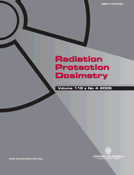-
Views
-
Cite
Cite
R. Sturm, W. Hofmann, A multi-compartment model for slow bronchial clearance of insoluble particles—extension of the ICRP human respiratory tract models, Radiation Protection Dosimetry, Volume 118, Issue 4, July 2006, Pages 384–394, https://doi.org/10.1093/rpd/nci358
Close - Share Icon Share
Abstract
To incorporate the various mechanisms that are presently assumed to be responsible for the experimentally observed slow bronchial clearance into the HRTM, a multi-compartment model was developed to simulate the clearance of insoluble particles in the tracheobronchial tree of the human lung. The new model considers specific mass transfer paths that may play an important role for slow bronchial clearance. These include the accumulation of particulate mass in the periciliary sol layer, phagocytosis of stored particles by airway macrophages and uptake of deposited mass by epithelial cells. Besides the gel layer representing fast mucociliary clearance, all cellular and non-cellular units involved in the slow clearance process are described by respective compartments that are connected by specific transfer rates. The gastrointestinal tract and lymph nodes are included into the model as final accumulation compartments, to which mass is transferred via the airway route and the transepithelial path. Predicted retention curves correspond well with previously published data.



